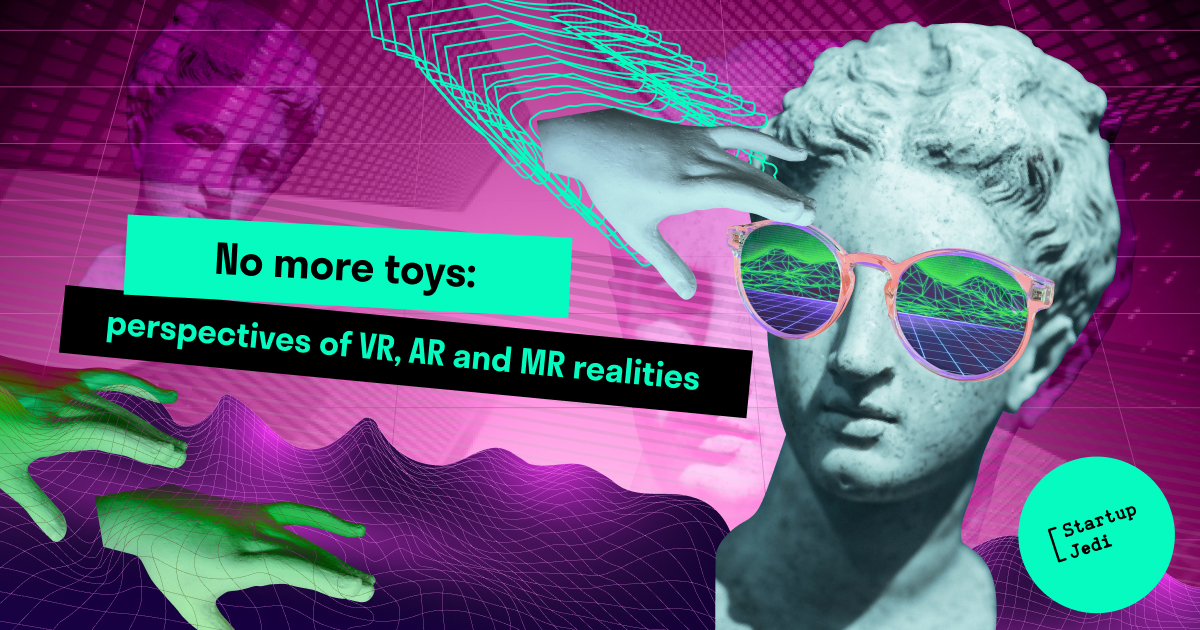
Startup Jedi
We talk to startups and investors, you get the value.
How alternative realities are adjusted by businesses and startups?

Startup Jedi
We talk to startups and investors, you get the value.
In March 2021, Microsoft announced the release of a Mesh platform for communication and collaboration, in which several users will be able to interact with each other using virtual 3D models. Large technology companies are increasingly investing in the development of VR, AR and MR solutions and taking them into account in marketing. Let’s see what products have been implemented and what are the prospects for new technologies.
...

Virtual reality (VR) is a reality created with the help of technologies, into which a person is immersed with the help of a special headset (gloves, helmets, headphones). Virtual reality has nothing to do with the surrounding reality. In the case of virtual reality, a person can receive an image, sound, taste and tactile sensations.
VR headsets can be divided into stand-alone and plug-in. Among the well-known means of virtual reality, there are: a virtual reality helmet, a virtual reality suit, MotionParallax3D displays, a virtual retinal monitor and virtual reality gloves.

Augmented reality adds new layers to the real world. A striking example from the gaming industry is Pokemon Go, an augmented reality game in which players search for Pokemon in real urban locations where pocket monsters are hiding. Unlike virtual reality, only pictures and sound are available in augmented reality.
Means of augmented reality: AR-glasses.

In mixed (another name is hybrid) reality, as the name already implies, virtual and augmented reality are connected. As a result, virtual models are not just superimposed on the real environment, but also allow you to interact with them using gestures and voice commands. This type of reality became popular after the release of the Microsoft HoloLensholographic computer (glasses).
MR headsets are represented by either glasses that allow you to see holograms, or glasses with built-in tracking cameras.
...

When and how did new types of reality appear?
...

According to a report by Digi-Capital, the virtual and augmented reality market will grow from $13B (2021) to $67B by 2024. In this connection, it is also worth considering that smartphone sales have been falling for the last two years in a row, and all major technology players are looking for something new. An alternative can be the means of augmented reality.
The growth of VR is facilitated by the development of hardware, including higher-quality and inexpensive headsets. AR development is supported by software development and the creation of standardized platforms for creating new applications.
The Russian market of VR/AR technologies in 2018 amounted to ₽1B. By 2021, it will grow to $178M.
Nevertheless, many marketing teams still do not know how to use the potential of new technologies in their products.
...

Historically, new types of reality have gained the greatest popularity in the entertainment industry: video games and movies. And yet VR, AR, MR are gradually penetrating into professional spheres.

The supplemented reality platform Magic Leap, whose value is estimated at $6B is represented by an augmented reality headset for business. It can be used for remote meetings with colleagues, collaboration, content sharing, and even visualization of complex 3D models.
An online game with virtual reality technology and a built-in Rec Room game creation system in 2021 received the status of a unicorn and is estimated at $1.25B. The startup receives income from in-game sales due to the pandemic and growing interest in the product.
Niantic, which launched Pokemon Go in 2016, has already become a leader in the field of augmented reality. The company is valued at more than $4B. Niantic specializes in creating VR/AR games in which players have to move a lot.
The Virtual Speech VR platform presents the practice of speech with a virtual audience or simulations. Users can learn from their own experiences in realistic immersive scenarios.
Vivid Vision is a medical startup that creates VR games that treat the lazy eye. The company cooperates with ophthalmological clinics around the world, providing modern methods of treatment of this disease.
Neurable — smart headphones that analyse brain signals promise to show the user how and when he works best, minimizing distractions and increasing concentration for the more active performance of actions. The device connects neurology with everyday life.

Facebook: facebook.com/StartupJedi/
Telegram: t.me/Startup_Jedi
Twitter: twitter.com/startup_jedi
Comments